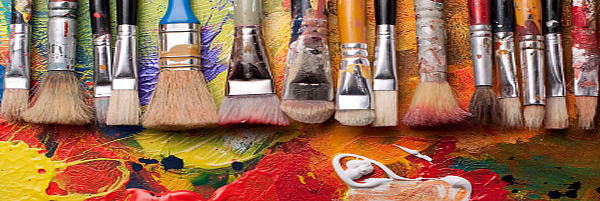Accomplished and novice painters alike know the importance of proper cleaning and maintenance of paint brushes. Taking the little extra time to properly clean your brushes after you paint will extend how long you can use them, saving you from continually having to buy new brushes. All it takes is a little lukewarm water, some mild soap, and a bit of patience.
Finished painting for the day? Follow these do’s and don’ts so that your next painting session will be just as enjoyable as the first!
DO:
- Wear gloves if you worry about the toxicity of your paint or the sensitivity of your skin. Pay attention: if the paint is staining your skin causing your skin to crack, use gloves!
- Use a clean, soft cloth or tissue, wipe off any excess paint. The best way to do this is to gently squeeze the bristles from the ferrule edge outwards to the tip with your fingers or a cloth.
- Rinse the brush. Oil paints require rinsing in turpentine or oil. Water-based mediums can be rinsed in lukewarm water.
- Wipe the brush on a cloth to remove the last of any paint.
- Wash the brush gently with a bit of mild soap or gentle dish soap. If your paints aren’t toxic, work up a small lather of soap and gently scrub the brush in your hands. Otherwise, dab the brush in soap (Gently, gently!) and make a lather in a container.
- Rinse, repeating until the water runs clean and there is no trace of any colour still coming out. Make sure there is no paint left within the bristles. Certain paints may permanently stain the bristles over time, but the brush will be perfectly fine to use – as long as you make sure to remove any lingering paint.
- Remove any leftover soap by doing a final rinse in clean, lukewarm water.
- Gently shape the head of your brush into its original shape with your fingers.
- If your brush is too misshapen to be shaped by your fingers, wrap a piece of toilet paper around the bristles while they are still wet. As the paper dries, it will pull the bristles into shape by contracting around them.
DON’T:
- Pull on the bristles to get excess paint out – pulling on bristles will tear some of them out.
- Use hot water. Hot water can damage the ferrule by expanding or loosening it, which can then cause the bristles to drop out.
- Leave your brushes to dry bristles down. If your brush dries head down, the bristles will splay our and dry misshapen. Put it handle-end first in an old yogurt container or jar.
- Let acrylic paint dry on a brush. Acrylic pain is water-resistant when dry – if you let it dry, it’s not coming off!
- Leave brushes standing in water. This is not proper care and can ruin them.
- Force paint out of brush using high water pressure. This will weaken the bristles, and can cause them to loosen and fall out. Rinse gently several times as opposed to blasting the brushes once.
PAINTER POINTERS:
- Use separate brushes for your oil paints and for water-based mediums. It’s also important to use separate brushes for masking fluid and varnish.
- Natural bristle brushes can stiffen and lose flexibility. If you desire, you can soften your brush: after cleaning it, dip it in a bit of the oil you use as a medium.
- Are your brushes out of shape? Sometimes you can reshape synthetic brushes by soaking them in hot (not boiling, but hot) water.










Speak Your Mind